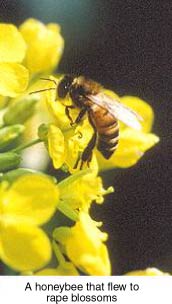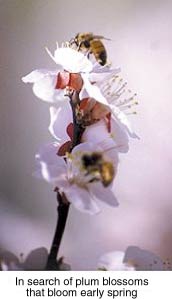 |
| Bee Square HOME | The Miraculous Life of Bees | A Surprising Story about Bees | Look into a honeycomb! | An Introduction to Beekeeping |
| Honeybee Restaurant | Beekeeping Reports from Around the World | Fairy Tales and Picture Books about Bees Story Collection | News From the Bee Farm | Links |
|
|

 |
Takayuki Ono |

|
It was a little later than usual that the queen bee started to lay eggs, an activity that had been suspended in the winter. Although there is some difference from swarm to swarm, every swarm seems to switch to "spring" mode around the first day of spring. Although it is pitch-dark inside the beehive, bees can probably discern the subtle turning of the seasons by checking the temperature and the length of the day. The only bees that have managed to survive the winter together with the queen bee are the worker bees that were born the previous autumn. In the world of honeybees, they are "old women." The queen bee is said to lay more than 1,000 eggs a day, during which time it consumes royal jelly. However, at the beginning of spring, there are no young honeybees to secrete royal jelly and the old worker bees can provide the queen bee with only small amounts of royal jelly. Thus, the queen bee is able to lay only a few eggs each day. |
 |

|
Spring is a season in which the weather undergoes frequent change, as is clear from the fact that the weather pattern called the "Sankanshion" (characterized by the alternation of three cold days with four warm days), the spring rainy season, and the spring freeze all occur. Thus, just when one thinks the warm days are here at last, it can abruptly become very cold. We need to be very attentive to the weather in such cases. Because the queen bee has started to lay eggs, the quantity of food consumed in the hive increases dramatically. However, if the days in which honeybees are unable to fly out of the beehive are numerous, starvation may result or it may become impossible to keep the offspring warm. To prevent such unforeseen accidents, we carefully inspect each beehive keeping in the mind the fact they all have their own unique requirements. |

 |
Beehives that have passed the winter in the southern region of Okayama Prefecture will soon be coming back to the bee farm near the milk vetch fields. The last year was the worst year we had ever experienced. The temperature was so low that it adversely affected the flowering period. And, even if flowers did bloom, only little nectar could be collected from them. I hope that this year will be one blessed with good weather. It is increasingly becoming more difficult every year to secure a source of nectar. Today too, I am giving my bees the greatest care I possibly can to ensure that they will be able to make more honey by gathering more pollen from the milk vetch flowers. |
Yamada Bee Farm (Kagaminocho Pref. Okayama)
Copyright(C)2005 Yamada Bee Farm All Rights Reserved.
|
